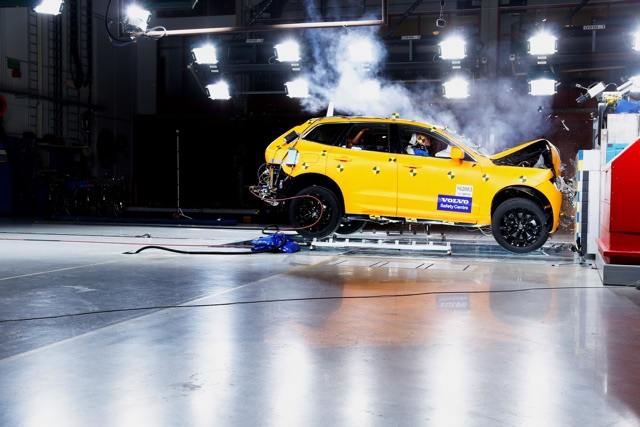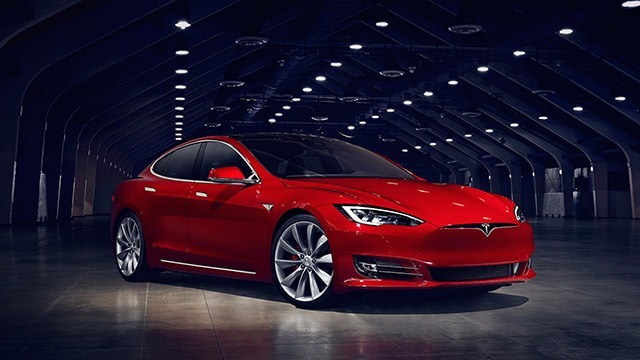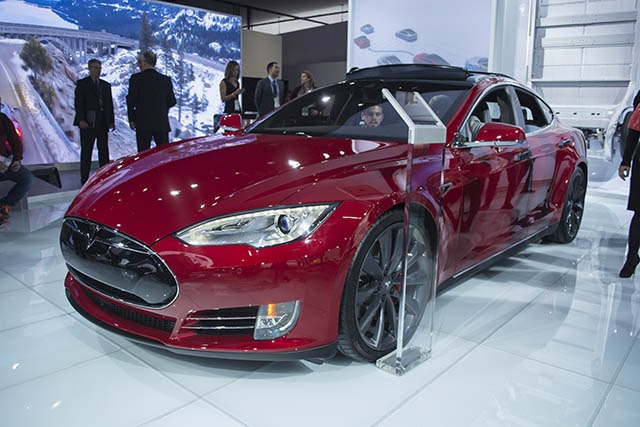Search the Community
Showing results for tags 'crash'.
-
Here is a paradox for you: Automakers have been increasing the number of safety features in their vehicles to help protect or avoid a crash. But this has also brought an unforeseen consquence; crash your vehicle and it is more likely that your insurance company will total it. That's according to a story from Automotive News who spoke with Bob Tschippert, senior vice president of Dallas-based underwriter Risk Theory. Tschippert explained that all of these new features has increased the costs of repairing a vehicle, thus causing the chance of an insurance company totaling vehicle to rise. "In the past, if you had a front-end collision, you had damage to the engine or the front end. But now, with the number of airbags that can run from $1,000 up to $4,000 and all the sensors up front, you're seeing more totals," said Tschippert. Throwing a wrench into this is the gargantuan Takata airbag recall. The backlog of vehicles needing replacement airbags might make it more likely for an insurance company to total a vehicle with Takata airbags in an effort to reduce the backlog. Other factors include an increase in the amount people drive and the issue of distracted driving. If there is a winner with this increased trend in totaling, it has to be salvage auctions. Insurance Auto Auctions Inc., announced back in March that it would be expanding some of their largest auctions in seven states. Source: Automotive News (Subscription Required) View full article
-
Here is a paradox for you: Automakers have been increasing the number of safety features in their vehicles to help protect or avoid a crash. But this has also brought an unforeseen consquence; crash your vehicle and it is more likely that your insurance company will total it. That's according to a story from Automotive News who spoke with Bob Tschippert, senior vice president of Dallas-based underwriter Risk Theory. Tschippert explained that all of these new features has increased the costs of repairing a vehicle, thus causing the chance of an insurance company totaling vehicle to rise. "In the past, if you had a front-end collision, you had damage to the engine or the front end. But now, with the number of airbags that can run from $1,000 up to $4,000 and all the sensors up front, you're seeing more totals," said Tschippert. Throwing a wrench into this is the gargantuan Takata airbag recall. The backlog of vehicles needing replacement airbags might make it more likely for an insurance company to total a vehicle with Takata airbags in an effort to reduce the backlog. Other factors include an increase in the amount people drive and the issue of distracted driving. If there is a winner with this increased trend in totaling, it has to be salvage auctions. Insurance Auto Auctions Inc., announced back in March that it would be expanding some of their largest auctions in seven states. Source: Automotive News (Subscription Required)
-
The National Transportation Safety Board (NTSB) has issued their preliminary report on the fatal crash involving a Tesla Model S in Autopilot mode and a semi-truck back in May. According to data that was downloaded from the Model S, the vehicle was traveling above the speed limit on the road (74 mph in 65) and that Autopilot was engaged. The speed helps explain how the Model S traveled around 347 feet after making the impact with the trailer - traveling 297 feet before hitting a utility pole, and then going another 50 feet after breaking it. The report doesn't have any analysis of the accident or a possible cause. NTSB says their investigators are still downloading data from the vehicle and looking at information from the scene of the crash. A final report is expected within the next 12 months. Car and Driver reached out for comment from both Tesla and Mobileye - the company that provides Tesla the chips that process the images being captured by Autopilot's cameras. Tesla didn't respond, but a blog post announcing the crash said: "neither Autopilot nor the driver noticed the white side of the tractor trailer against a brightly lit sky, so the brake was not applied." A spokesman for Mobileye told the magazine that their chips aren't designed to flag something like the scenario that played out in the crash. “The design of our system that we provide to Tesla was not . . . it’s not in the spec to make a decision to tell the vehicle to do anything based on that left turn, that lateral turn across the path. Certainly, that’s a situation where we would hope to be able to get to the point where the vehicle can handle that, but it’s not there yet,” said Dan Galves, a Mobileye spokesperson. It should be noted that hours before NTSB released their report, Mobileye announced that it would end its relationship with Tesla once their current contract runs out. The Wall Street Journal reports that disagreements between the two on how the technology was deployed and the fatal crash caused the separation. “I think in a partnership, we need to be there on all aspects of how the technology is being used, and not simply providing technology and not being in control of how it is being used,” said Mobileye Chief Technical Officer Amnon Shashua during a call with analysts. “It’s very important given this accident…that companies would be very transparent about the limitations” of autonomous driving systems, said Shashua. “It’s not enough to tell the driver to be alert but to tell the driver why.” Recently, Mobileye announced a partnership with BMW and Intel in an attempt to get autonomous vehicles on the road by 2021. Source: NTSB, 2, Car and Driver, Wall Street Journal (Subscription Required) View full article
-
The National Transportation Safety Board (NTSB) has issued their preliminary report on the fatal crash involving a Tesla Model S in Autopilot mode and a semi-truck back in May. According to data that was downloaded from the Model S, the vehicle was traveling above the speed limit on the road (74 mph in 65) and that Autopilot was engaged. The speed helps explain how the Model S traveled around 347 feet after making the impact with the trailer - traveling 297 feet before hitting a utility pole, and then going another 50 feet after breaking it. The report doesn't have any analysis of the accident or a possible cause. NTSB says their investigators are still downloading data from the vehicle and looking at information from the scene of the crash. A final report is expected within the next 12 months. Car and Driver reached out for comment from both Tesla and Mobileye - the company that provides Tesla the chips that process the images being captured by Autopilot's cameras. Tesla didn't respond, but a blog post announcing the crash said: "neither Autopilot nor the driver noticed the white side of the tractor trailer against a brightly lit sky, so the brake was not applied." A spokesman for Mobileye told the magazine that their chips aren't designed to flag something like the scenario that played out in the crash. “The design of our system that we provide to Tesla was not . . . it’s not in the spec to make a decision to tell the vehicle to do anything based on that left turn, that lateral turn across the path. Certainly, that’s a situation where we would hope to be able to get to the point where the vehicle can handle that, but it’s not there yet,” said Dan Galves, a Mobileye spokesperson. It should be noted that hours before NTSB released their report, Mobileye announced that it would end its relationship with Tesla once their current contract runs out. The Wall Street Journal reports that disagreements between the two on how the technology was deployed and the fatal crash caused the separation. “I think in a partnership, we need to be there on all aspects of how the technology is being used, and not simply providing technology and not being in control of how it is being used,” said Mobileye Chief Technical Officer Amnon Shashua during a call with analysts. “It’s very important given this accident…that companies would be very transparent about the limitations” of autonomous driving systems, said Shashua. “It’s not enough to tell the driver to be alert but to tell the driver why.” Recently, Mobileye announced a partnership with BMW and Intel in an attempt to get autonomous vehicles on the road by 2021. Source: NTSB, 2, Car and Driver, Wall Street Journal (Subscription Required)
-

NHTSA Opens Investigation Into Fatal Crash With Tesla's Autopilot
William Maley posted an article in Tesla
The National Highway Transportation Safety Administration (NHTSA) has opened an investigation into a fatal crash dealing with Tesla's Autopilot system. In a statement given to Reuters, NHTSA said the driver of a 2015 Tesla Model S was killed while the vehicle was in the Autopilot mode. The crash took place on May 7th in Williston, Florida when a tractor-trailer was making a left turn across a divided highway. Tesla in a lengthy blog post said: "neither Autopilot nor the driver noticed the white side of the tractor trailer against a brightly lit sky, so the brake was not applied." The Model S drove underneath the trailer with the bottom making contact with the windshield. The Verge reports the driver was 40-year old Joshua Brown who filmed various videos of his Model S. One of the videos on his YouTube channel showed his Model avoiding an accident with a bucket truck. NHTSA's investigation will look the design and performance of the Model S and its various components, including Autopilot. It should be noted this is standard practice for NHTSA to investigate any crash where the vehicle's system could be at fault. Tesla's blog post says this is first known fatality in over 130 million miles since Autopilot was turned on. Autopilot has been a source of controversy since Tesla rolled it out last year. Numerous videos of Model S owners filming themselves in dangerous situations and sometimes showing the system not working caused Tesla to make some drastic changes. These included limiting the types of road the system could be turned on and making checks to see if there was someone sitting in the driver's seat. Tesla has said time and time again that Autopilot is a beta feature and that the driver needed to pay attention. "Autopilot is getting better all the time, but it is not perfect and still requires the driver to remain alert," Tesla said in their post. "It is important to note that Tesla disables Autopilot by default and requires explicit acknowledgement that the system is new technology and still in a public beta phase before it can be enabled. When drivers activate Autopilot, the acknowledgment box explains, among other things, that Autopilot “is an assist feature that requires you to keep your hands on the steering wheel at all times," and that "you need to maintain control and responsibility for your vehicle” while using it. " Nevertheless, this crash puts autonomous technologies and Tesla under some intense scrutiny. Source: Automotive News (Subscription Required), The Detroit News, Reuters, Tesla, The Verge -
The National Highway Transportation Safety Administration (NHTSA) has opened an investigation into a fatal crash dealing with Tesla's Autopilot system. In a statement given to Reuters, NHTSA said the driver of a 2015 Tesla Model S was killed while the vehicle was in the Autopilot mode. The crash took place on May 7th in Williston, Florida when a tractor-trailer was making a left turn across a divided highway. Tesla in a lengthy blog post said: "neither Autopilot nor the driver noticed the white side of the tractor trailer against a brightly lit sky, so the brake was not applied." The Model S drove underneath the trailer with the bottom making contact with the windshield. The Verge reports the driver was 40-year old Joshua Brown who filmed various videos of his Model S. One of the videos on his YouTube channel showed his Model avoiding an accident with a bucket truck. NHTSA's investigation will look the design and performance of the Model S and its various components, including Autopilot. It should be noted this is standard practice for NHTSA to investigate any crash where the vehicle's system could be at fault. Tesla's blog post says this is first known fatality in over 130 million miles since Autopilot was turned on. Autopilot has been a source of controversy since Tesla rolled it out last year. Numerous videos of Model S owners filming themselves in dangerous situations and sometimes showing the system not working caused Tesla to make some drastic changes. These included limiting the types of road the system could be turned on and making checks to see if there was someone sitting in the driver's seat. Tesla has said time and time again that Autopilot is a beta feature and that the driver needed to pay attention. "Autopilot is getting better all the time, but it is not perfect and still requires the driver to remain alert," Tesla said in their post. "It is important to note that Tesla disables Autopilot by default and requires explicit acknowledgement that the system is new technology and still in a public beta phase before it can be enabled. When drivers activate Autopilot, the acknowledgment box explains, among other things, that Autopilot “is an assist feature that requires you to keep your hands on the steering wheel at all times," and that "you need to maintain control and responsibility for your vehicle” while using it. " Nevertheless, this crash puts autonomous technologies and Tesla under some intense scrutiny. Source: Automotive News (Subscription Required), The Detroit News, Reuters, Tesla, The Verge View full article
-
G. David Felt Staff Writer Alternative Energy - www.CheersandGears.com Bloomberg Predicts another OIL Crash with NO Recovery, Maybe Many of us are excited with the big drop in oil prices and finally gas prices retreating to below $2 a gallon in many places around the US. Some here on Cheers and Gears even feel that alternative energy auto's are a waste of time or should not even be bothered with. So it was with interest when I saw this story on Bloombergs web site. Another Oil Crash Is Coming, and There May Be No RecoveryThe focus on this is that with Tesla in 2017 and Chevy later this year, 2016 beginning to sell 200 Mile, $30,000 auto's, other Auto OEMs spending Billions to also field electric auto's with long battery pack range that the days of Dino powered auto's are limited. Bloomberg clearly states that OPEC and even ExxonMobil have reported that they only see EV auto's making up 1% at most by 2040 on the planet. What no one saw was the Huge growth in US oil fields in 2014 and a global glut of 2 million barrels of oil a day sitting on the market. Bloomberg reviewed world wide data to see that EV Auto's grew by 60% in 2015, show no signs of slowing down among governments push to reduce smog in cities around the world. Based on buying trends and who fast things can change, Bloomberg is predicting that by 2023 we will see another 2 million barrels of Oil being unused on the market leading to this prediction of another crash and the power of the Oil Companies being reduced. The video they have on their story is also very interesting to watch and listen too. Review the original story, watch the video and sound off on what you think of the OIL Industry and where we are headed with auto's! Bloomberg Oil Crash Story
-
Impressive Porsche crash video!





